Cornering basics 1 - assessing the bend (limit point)
Discussion
This is the first in a series of articles on cornering, and to make it easier to understand, I've been out and taken some photographs. I only hope that I manage to post them properly, otherwise this will make as much sense as quantum mechanics if the pictures don't come out.
Anyway, for the first couple of parts in this series, I've decided to look at something else that is considered a bit of a "black art" - assessing the severity of bends. There's not really any secret to it, but I've heard some ruddy complicated explanations in the past, so it's not surprising that some people think it involves voodoo. I'll try to stick to my mantra of KISS - Keep It Simple, Stupid - and you'll probably find that, actually, it's quite straightforward and that you probably use a lot of these skills already.
THE LIMIT POINT
Let's deal with this little chestnut to start with, as it's the one that most people struggle to get their heads round. Have a look at this picture of a section of road - you can see a straight piece of road over a motorway bridge, followed by a left-hand bend in the distance...
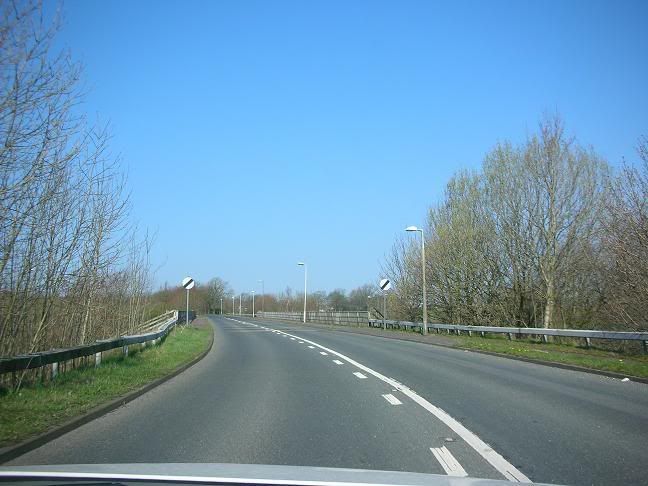
Now, there's plenty to look at - it's obvious we're coming off a left-hand bend with double white lines, there are some NSL signs, the road goes over a bridge, there are some street lights on the offside, some rumble-strips which are, presumably for traffic travelling towards us, a change from double white to hazard lines, and, right in the distance, you can see the limit point for the left-hand bend.
What? Oh, sorry - I didn't explain - the limit point has been described to me as "the furthest point at which you have an uninterrupted view of the road surface", which sounds a little pompous, and "The point at which the nearside and offside verges seem to meet", which is a bit better, but the opposite verges of a road don't actually meet, do they? That'd be silly. A better description would be "The furthest point you can see the road surface" - less pompous I think, and straight to the point. Straight to the limit point, in fact.
For the next few pictures, however, I've recruited an assistant in the form of the hand of God, who will point out the limit point for you (Obviously, in these politically correct days, it doesn't have to be the hand of God - insert "Allah", "Brahman", "Ishvara", "Vahiguru", "Senna" or whatever else takes your fancy).
Anyway, here's the same picture again, with the limit point indicated...
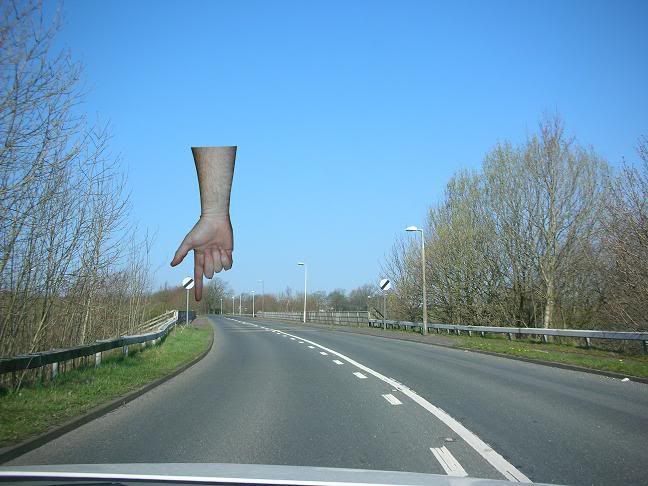
As you can see, the limit point is waaay in the distance, but although the driver may be performing other actions at this point on the road, such as changing to a flexible gear, checking the mirror and preparing to accelerate, they'll be paying some attention to that limit point, as it will help them to determine the severity of the next bend, and assist them in mentally preparing a plan as to how to drive through the corner.
The thing to look for with a limit point is it's relative position to you as you approach. If you seem to be getting closer to it as you approach the bend, then the bend will be quite tight. If it seems to be remaining a constant distance from you, as, for instance, a rainbow does as you move towards it, then the bend isn't getting any tighter. If the limit point seems to be going further away, then the bend is opening up and the road is straightening.
Lets recruit Gods help again, and look at where the limit point is after we've moved a short distance up the road...
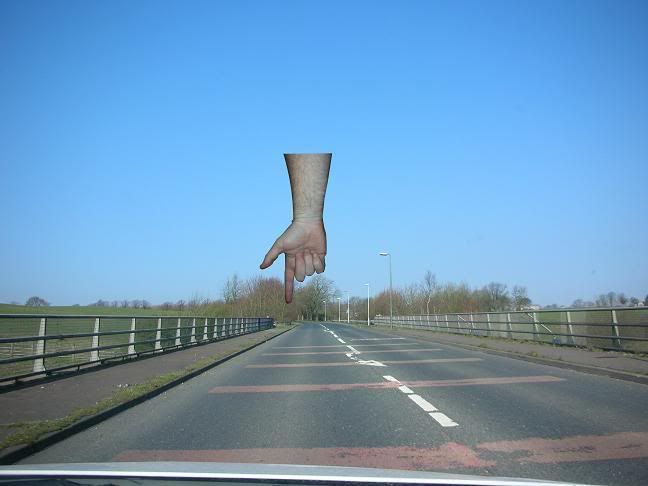
Right - we've moved forwards onto the bridge now, the driver will be accelerating at this point, and their focus will be towards the corner. Look left from the bend, across the adjacent fields, to see if there is a view of the road, as this can assist in assessing how tight it is. In this case, there isn't a view to the left, so we're relying on the limit point to show how tight it is. With help from the hand of God, you can see that we appear to be getting closer to it.
Let's move a bit further forward...
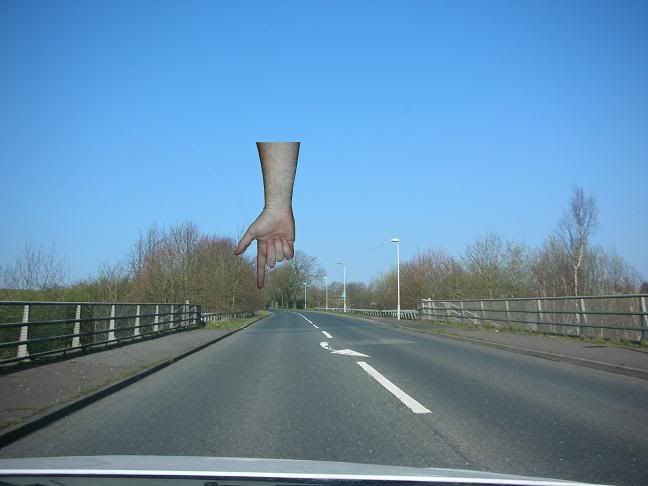
We're halfway across the bridge now and we're still getting closer to the limit point. There are some other clues as to how tight the bend is though, and they're in the form of what you can't see, more than what you can see.
You can't see a triangle warning sign for the bend, you can't see a chevron board to the left, you can't see a change back to double white lines and you can't see a "SLOW" painted on the road. The fact that you can't see these things is an indicator that the bend won't be particularly tight.
One other thing - take notice how many lamp-posts you can see to the right in this picture, as it'll give you a guide to how far forward I'm moving, and what the limit point is doing. In the above picture, you can see four lamp-posts.
Let's move on again - God, it's over to you...
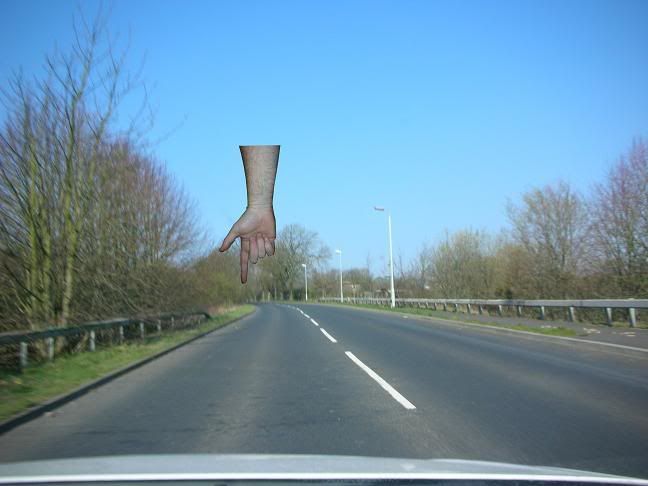
From this one, you can see that I've moved forward by one lamp-post, and now the limit point has started moving forwards too. This is a critical point, as, when you're driving through this bend, the limit point is now acting like a rainbow, and moving away at the same rate as we're driving towards it. As we're still a distance away from the bend, this means that it's going to be a quite open corner, so we're unlikely to have to lose much, if any speed to negotiate it.
On to the next one...
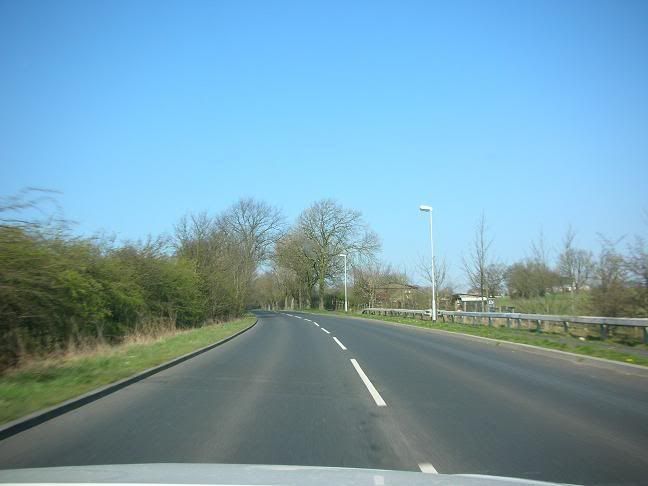
Well, we've only moved forward another lamp-post, but things have changed quite dramatically on the limit-point front. So dramatically, in fact, that in that short distance, the limit point has shot off away from us, and no longer exists, so we've nothing for the hand of God to point at any more. Look at where we are on the road - we're only just entering the bend, and yet the limit point has gone completely, and we can quite happily accelerate through the corner.
Obviously, it's very easy from that position to see that the corner is nice and open, but if you've paid attention to the limit point from when it first becomes visible, then you can work out how open or tight the bend is from much further back, which obviously helps you to make your all-important driving plans.
There are many more ways of assessing the severity of corners, and I'll look at them next time.
Anyway, for the first couple of parts in this series, I've decided to look at something else that is considered a bit of a "black art" - assessing the severity of bends. There's not really any secret to it, but I've heard some ruddy complicated explanations in the past, so it's not surprising that some people think it involves voodoo. I'll try to stick to my mantra of KISS - Keep It Simple, Stupid - and you'll probably find that, actually, it's quite straightforward and that you probably use a lot of these skills already.
THE LIMIT POINT
Let's deal with this little chestnut to start with, as it's the one that most people struggle to get their heads round. Have a look at this picture of a section of road - you can see a straight piece of road over a motorway bridge, followed by a left-hand bend in the distance...

Now, there's plenty to look at - it's obvious we're coming off a left-hand bend with double white lines, there are some NSL signs, the road goes over a bridge, there are some street lights on the offside, some rumble-strips which are, presumably for traffic travelling towards us, a change from double white to hazard lines, and, right in the distance, you can see the limit point for the left-hand bend.
What? Oh, sorry - I didn't explain - the limit point has been described to me as "the furthest point at which you have an uninterrupted view of the road surface", which sounds a little pompous, and "The point at which the nearside and offside verges seem to meet", which is a bit better, but the opposite verges of a road don't actually meet, do they? That'd be silly. A better description would be "The furthest point you can see the road surface" - less pompous I think, and straight to the point. Straight to the limit point, in fact.
For the next few pictures, however, I've recruited an assistant in the form of the hand of God, who will point out the limit point for you (Obviously, in these politically correct days, it doesn't have to be the hand of God - insert "Allah", "Brahman", "Ishvara", "Vahiguru", "Senna" or whatever else takes your fancy).
Anyway, here's the same picture again, with the limit point indicated...

As you can see, the limit point is waaay in the distance, but although the driver may be performing other actions at this point on the road, such as changing to a flexible gear, checking the mirror and preparing to accelerate, they'll be paying some attention to that limit point, as it will help them to determine the severity of the next bend, and assist them in mentally preparing a plan as to how to drive through the corner.
The thing to look for with a limit point is it's relative position to you as you approach. If you seem to be getting closer to it as you approach the bend, then the bend will be quite tight. If it seems to be remaining a constant distance from you, as, for instance, a rainbow does as you move towards it, then the bend isn't getting any tighter. If the limit point seems to be going further away, then the bend is opening up and the road is straightening.
Lets recruit Gods help again, and look at where the limit point is after we've moved a short distance up the road...

Right - we've moved forwards onto the bridge now, the driver will be accelerating at this point, and their focus will be towards the corner. Look left from the bend, across the adjacent fields, to see if there is a view of the road, as this can assist in assessing how tight it is. In this case, there isn't a view to the left, so we're relying on the limit point to show how tight it is. With help from the hand of God, you can see that we appear to be getting closer to it.
Let's move a bit further forward...

We're halfway across the bridge now and we're still getting closer to the limit point. There are some other clues as to how tight the bend is though, and they're in the form of what you can't see, more than what you can see.
You can't see a triangle warning sign for the bend, you can't see a chevron board to the left, you can't see a change back to double white lines and you can't see a "SLOW" painted on the road. The fact that you can't see these things is an indicator that the bend won't be particularly tight.
One other thing - take notice how many lamp-posts you can see to the right in this picture, as it'll give you a guide to how far forward I'm moving, and what the limit point is doing. In the above picture, you can see four lamp-posts.
Let's move on again - God, it's over to you...

From this one, you can see that I've moved forward by one lamp-post, and now the limit point has started moving forwards too. This is a critical point, as, when you're driving through this bend, the limit point is now acting like a rainbow, and moving away at the same rate as we're driving towards it. As we're still a distance away from the bend, this means that it's going to be a quite open corner, so we're unlikely to have to lose much, if any speed to negotiate it.
On to the next one...

Well, we've only moved forward another lamp-post, but things have changed quite dramatically on the limit-point front. So dramatically, in fact, that in that short distance, the limit point has shot off away from us, and no longer exists, so we've nothing for the hand of God to point at any more. Look at where we are on the road - we're only just entering the bend, and yet the limit point has gone completely, and we can quite happily accelerate through the corner.
Obviously, it's very easy from that position to see that the corner is nice and open, but if you've paid attention to the limit point from when it first becomes visible, then you can work out how open or tight the bend is from much further back, which obviously helps you to make your all-important driving plans.
There are many more ways of assessing the severity of corners, and I'll look at them next time.
Edited by R_U_LOCAL on Sunday 1st April 23:06
Excellent, as ever, Reg. Looking forward to the next chapter.
I have to take issue with you on one point, though:
As a paid-up member of the Evil Atheist Conspiracy (TM), I am deeply offended by the above paragraph. It is an insult to my non-belief to invoke mythical beings as an aid to explanation. At least use the FSM's noodly appendage in future articles. Then everyone can be offended.
I have to take issue with you on one point, though:
R_U_LOCAL said:
For the next few pictures, however, I've recruited an assistant in the form of the hand of God, who will point out the limit point for you (Obviously, in these politically correct days, it doesn't have to be the hand of God - insert "Allah", "Brahman", "Ishvara", "Vahiguru", "Senna" or whatever else takes your fancy).
As a paid-up member of the Evil Atheist Conspiracy (TM), I am deeply offended by the above paragraph. It is an insult to my non-belief to invoke mythical beings as an aid to explanation. At least use the FSM's noodly appendage in future articles. Then everyone can be offended.

AL666 said:
Thanks for explaining the limit point to us Reg... Just out of curiosity, does the road bend to the right next, or is it straight? I'm finding it hard to see from the photo.
Cheers,
AL
Cheers,
AL
Look at the treeline in piccie 3.... They're following a feature of some sort which is more than likely the road. Although more information becomes available as you continually "read the book" you have an early clue that it's probably a sweeping left hander.
Interesting thread as always.
Although I have never seen Limit Points formalised in such a way, the concept is something that I discovered for myself not long after learning to drive*, where as it appears to remain a completely alien concept to most of my friends.
While I realise the thread is the first in the series, and you need to start at the start, would you expect an average driver, (ie neither new nor advanced), to be able to judge unknown corners, or is it a skill that is foreign to most people?
*this was not intended as a boast in anyway
Although I have never seen Limit Points formalised in such a way, the concept is something that I discovered for myself not long after learning to drive*, where as it appears to remain a completely alien concept to most of my friends.
While I realise the thread is the first in the series, and you need to start at the start, would you expect an average driver, (ie neither new nor advanced), to be able to judge unknown corners, or is it a skill that is foreign to most people?
*this was not intended as a boast in anyway
sato said:
Interesting thread as always.
Although I have never seen Limit Points formalised in such a way, the concept is something that I discovered for myself not long after learning to drive*, where as it appears to remain a completely alien concept to most of my friends.
While I realise the thread is the first in the series, and you need to start at the start, would you expect an average driver, (ie neither new nor advanced), to be able to judge unknown corners, or is it a skill that is foreign to most people?
*this was not intended as a boast in anyway
Although I have never seen Limit Points formalised in such a way, the concept is something that I discovered for myself not long after learning to drive*, where as it appears to remain a completely alien concept to most of my friends.
While I realise the thread is the first in the series, and you need to start at the start, would you expect an average driver, (ie neither new nor advanced), to be able to judge unknown corners, or is it a skill that is foreign to most people?
*this was not intended as a boast in anyway
I've long felt that one of the reasons for people still braking half-way through a corner is simply that they are unable to judge it sufficiently well until it's too late. Of course, familiarity is a also a problem: "I know this corner, it's how I've always done it" sort of thing.
BliarOut said:
Look at the treeline in piccie 3.... They're following a feature of some sort which is more than likely the road. Although more information becomes available as you continually "read the book" you have an early clue that it's probably a sweeping left hander.
I reckon it curves right round the village and past the church before heading out again and up the hill.
7db said:
BliarOut said:
Look at the treeline in piccie 3.... They're following a feature of some sort which is more than likely the road. Although more information becomes available as you continually "read the book" you have an early clue that it's probably a sweeping left hander.
I reckon it curves right round the village and past the church before heading out again and up the hill.
I reckon you know where the road is

BliarOut said:
7db said:
BliarOut said:
Look at the treeline in piccie 3.... They're following a feature of some sort which is more than likely the road. Although more information becomes available as you continually "read the book" you have an early clue that it's probably a sweeping left hander.
I reckon it curves right round the village and past the church before heading out again and up the hill.
I reckon you know where the road is

I don't reckon he does.

All will be revealed in the next installment.
R_U_LOCAL said:
I don't reckon he does. 
All will be revealed in the next installment.

All will be revealed in the next installment.
Ok - had a closer look at all the available information
Reckon we're looking at a half right into a straight up the hill which is visible in the early photos with trees lining it. Clearly doesn't go off left until much later (if at all) as we can see the fields early on. Checking further up right early on there's some buildings (farm? factory?) which were visible as we crossed the bridge and after the trees cleared - must exit onto something. Our road going up right?
R_U_LOCAL said:
We're halfway across the bridge now and we're still getting closer to the limit point. There are some other clues as to how tight the bend is though, and they're in the form of what you can't see, more than what you can see.
You can't see a triangle warning sign for the bend, you can't see a chevron board to the left, you can't see a change back to double white lines and you can't see a "SLOW" painted on the road. The fact that you can't see these things is an indicator that the bend won't be particularly tight.
You can't see a triangle warning sign for the bend, you can't see a chevron board to the left, you can't see a change back to double white lines and you can't see a "SLOW" painted on the road. The fact that you can't see these things is an indicator that the bend won't be particularly tight.
Is it just me, or is this something that is often very differently applied from one county planning department to another?
Whilst I've yet to actually come across chevrons and bend signs on a straight, I've certainly come across quite a few, including those that flag up a speed lower than the prevailing speed limit, when there is absolutely nothing whatsoever to stop you maintaining your speed on or above the limit. Conversely, but less often, I've come across bends that are not signed at all, and yet turn out to be pretty sharp. It makes me wonder if the planners set out to sign the sharpest 20% of bends in their counties, leading to big differences across the country!
Excellent article Reg, but one clue you missed; as you cross the bridge you can also see arrows in the road telling oncoming traffic to get back onto their own side of the road. This in itself is an indicator of the openness of the approaching bend; if it were tight, and therefore of limited visibilty, it would have double whites and traffic would not be overtaking. The arrows are an early indicator that oncoming traffic is at liberty to overtake through the approaching "bend", therefore it is going to be open.
Major Bloodnok said:
Excellent, as ever, Reg. Looking forward to the next chapter.
I have to take issue with you on one point, though:
As a paid-up member of the Evil Atheist Conspiracy (TM), I am deeply offended by the above paragraph. It is an insult to my non-belief to invoke mythical beings as an aid to explanation. At least use the FSM's noodly appendage in future articles. Then everyone can be offended.
I have to take issue with you on one point, though:
R_U_LOCAL said:
For the next few pictures, however, I've recruited an assistant in the form of the hand of God, who will point out the limit point for you (Obviously, in these politically correct days, it doesn't have to be the hand of God - insert "Allah", "Brahman", "Ishvara", "Vahiguru", "Senna" or whatever else takes your fancy).
As a paid-up member of the Evil Atheist Conspiracy (TM), I am deeply offended by the above paragraph. It is an insult to my non-belief to invoke mythical beings as an aid to explanation. At least use the FSM's noodly appendage in future articles. Then everyone can be offended.

Or maybe next time invoke "The Hand of Bod"

More seriously, another great article. Looking forward to the next one on "wickedly decreasing radius corners with wholly inadequate warning markings"

Syd knee said:
Victor, I think you are wrong in this. Those arrows are a requirement to inform drivers of the impending continuous white line and bear no relevance to what the road for them has been like.
No, if you think about it I'm not. They imply that the road ahead is open, as otherwise no one would be overtaking in the first place to have to get back on their side. It's not a big indicator, but it's an indicator nonetheless. Do I detect a hint of IAM pedantry? I *know* what they *mean*, thanks.
Edited by victormeldrew on Tuesday 3rd April 16:51
Victor, that was not my intention at all. Somerset County Council have gone mad with continuous white lines including the bizarre sign of "beware oncoming vehicles in the middle of the road" in a section of double white lines???????.
There use is laid out in chapter 5 of the traffic signs manual. The arrows must appear at set distances before the commencement of the line even if that is following a T junction or a pedestrian crossing where no one should be overtaking anyhow. There distance apart is set by the average speed reeding for the carriage way. If you could calculate that distance and back calculate the speed it would give you a speed to take the bend at, but that is beyond most mortals
There use is laid out in chapter 5 of the traffic signs manual. The arrows must appear at set distances before the commencement of the line even if that is following a T junction or a pedestrian crossing where no one should be overtaking anyhow. There distance apart is set by the average speed reeding for the carriage way. If you could calculate that distance and back calculate the speed it would give you a speed to take the bend at, but that is beyond most mortals
Gassing Station | Advanced Driving | Top of Page | What's New | My Stuff




